
Antarctic Voyage
For the last few years, Debbie has been trying to talk Dad into going on a cruise to Antarctica that was sponsored by the American Museum of Natural History. When Dad received a flyer from the Caltech Alumni Association for the same cruise that Debbie had been promoting, he called her up to suggest that they should sign up.
Link to the Smithsonian Institute's web page describing the voyage.
The cruise was composed largely of three charter groups; Caltech Alumni and Associates, Smithsonian Institution, and the American Museum of Natural History. It turned out that there were also a few independent people who had booked their cruises directly through Radisson.
Elaine accompanied Dad for the cruise, plus extension trips to Easter Island before the cruise and the Patagonia Lake District after the cruise. Debbie and I signed on for just the cruise to Antarctica.
Sunday, January 14 - In Transit
The first leg of the journey was Lan Chile flight 601 to Buenos Aires, with stops in Lima, Peru and Santiago, Chile. It was scheduled to depart at 12:15 in the afternoon and the travel literature recommended checking in three hours ahead of the departure.
Jill Evensizer let me park my 4Runner at her house and gave me a ride to the airport on Sunday morning. She dropped me near the front of the Bradley terminal. I picked up my suitcase, duffel bag, laptop computer, and camera bag and shuffled into the terminal with the load.
The Lan Chile counter had not yet opened when I got in line. Other Antarctic cruise passengers were beginning to join the queue. Eventually, the counter opened and I got my bags checked.
Debbie was scheduled to come into Los Angeles on a Southwest flight. I debated whether to try to meet her at her arrivel terminal, but I decided that there was a good chance that we might pass each other on the way, so I selected a seat in the lobby that insured that I would see her when she arrived.
Debbie arrived and checked her bags. We still had a couple of hours before our flight departed, so we headed up to the food court to look for some breakfast. We found a café that served a big "American breakfast" and pigged out on eggs, sausages, potatoes, and toast. It proved to be a good decision, because we would not be adequately fed on the flights to Buenos Aires.
Our airplane was a Boeing 767-300. The seating was 2-3-2. Debbie had a window seat, and I had the aisle seat next to her on the left side of the airplane. We took off on schedule and headed south along the Southern California coast. After a while we could see Baja California below us and the Gulf of California on our left. We overheard Joann Stock, a professor from Caltech, pointing out where she had done geologic fieldwork on the peninsula. We flew straight down the spine of Baja and then out over the Pacific Ocean, well to the west of Mexico.
The flight to Lima, Peru took over eight hours. The in-flight movie was Chicken Run.
After a while I noticed that the floor in front of me was littered with tissues. The seats in the row in front of us were occupied by Diane Binney, the Caltech Alumni Association tour leader, and a resident of the Argentine town of Uhsuaia. The passenger from Ushuaia had a terrible cold. He kept asking the stewardesses for tissues. Once he had used them he just tossed them on the floor around him. By the end of the flight, Debbie was calling him "The Pig".
We moved through three time zones on the way to Lima and landed at about 11:00 P.M., local time. We would continue on the same airplane to Santiago. The plane would be on the ground for nearly an hour, so they gave us the option of getting off the plane and going into the airport for a few minutes.
Debbie and I exited the airplane along with several of the other cruise passengers. We walked down the stairs at the back of the plane and across the tarmac to the airport building. A stewardess handed each of us a "transit" card as we entered the building. We found our way around to the waiting area.
There were several gift shops selling Peruvian souvenirs. I made use of the restroom facilities, but the factory produced native handcrafts for sale at the souvenir stands did not interest me. There was still a while before boarding when we arrived at the waiting area for our airplane. The tissue tossing Pig had exited the airplane with us. When he wandered over to stand next to me in the waiting area, I immediately picked up my things and wandered in a circle around the room to get away from the probably contagious disease carrier.
Monday, January 15 - Arrival in Buenos Aires
It was early on Monday morning when we were allowed to get back on the plane. It was loaded to capacity again and we took off for the leg of the flight to Santiago, Chile. We crossed two more time zones, landing in Santiago at 6:00 A.M, local time.
We had to change planes in Santiago. It is a much more modern and well-appointed airport than the one at Lima. The waiting area features a small restaurant shaped like a sailing vessel.
The continuing passengers began to look for the waiting area for our next flight. The sign at the information kiosk showed that flight 601 would depart from gate 1. It was quickly apparent that the lowest gate number was gate 10 and people started lining up at the kiosk to ask where to go. A Lan Chile representative approached the sign that indicated the gate numbers and put a 5 next to the 1. We were supposed to be waiting at gate number 15.
The sun rose while we waited for our next flight. Was could see that the airport was surrounded by mountains in most directions. The Andes mountain range was just a short distance away.
We boarded a second Lan Chile 767-300 and took off early in the morning. The airplane climbed out over the rugged Andes. Many of the valleys in the upper reaches of the mountains contained glaciers. The mountains extended out of sight both to the north and south. It took just a half-hour to cross the Andes, and then we were over the Pampas. The land below was divided into ranches and looked very much like the mid-west United States.
We arrived in Buenos Aires about two hours later. Although we had flown nearly due east across the continent, the time did not change between Chile and Argentina. It was 10:00 in the morning when we landed. After we collected our baggage, we were met by a number of porters. They took our bags and loaded them into a truck for the ride to the Caesar Park Hotel.
We gathered in three tour buses for the half-hour ride to the hotel. The Caesar Park Hotel was very nicely appointed. They had snacks, water, and tea waiting for us as we received our room assignments. Our suitcases were waiting for us in our room, but the duffel bags were nowhere to be seen. We pointed out that we were missing bags to the bellhop, and he went off to seek them out. A while later he returned with the bags, mumbling something about them having been put in with unclaimed luggage.
Link to the Caesar Park Hotel.
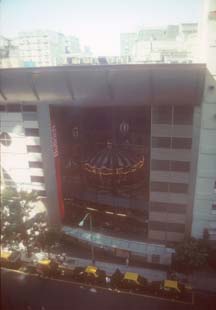 Our room looked out of the front of the hotel.
Across the street was a multi-story restaurant complex with a
carousel on the second floor. Yellow and Black taxis lined up in
front of the complex, waiting to pick up fares. When the driver
at the head of the line departed with a fare, the other drivers
pushed their cabs forward without starting their engines.
Our room looked out of the front of the hotel.
Across the street was a multi-story restaurant complex with a
carousel on the second floor. Yellow and Black taxis lined up in
front of the complex, waiting to pick up fares. When the driver
at the head of the line departed with a fare, the other drivers
pushed their cabs forward without starting their engines.
Debbie and I were free to do as we pleased for the afternoon. We went down to the reception area to ask about recommendations for dinner. Our Buenos Aires hostess suggested a restaurant a couple of blocks away that was called el Mirasol de Recova. She admitted that we could get a decent steak there, but suggested that if we wanted a place with atmosphere and tango dancing she recommended another place that we could take a cab to get to. We preferred not to subject ourselves to a cab ride through what had been confused and dangerous looking traffic.
The hostess seemed amused that we requested reservations at the restaurant for 6:00 P.M. Normally, Argentines dine much later in the evening. We walked over to the restaurant and found it located underneath a highway overpass with several other fancy establishments. The other restaurants were all still empty and not all of them had opened yet.
Only one other couple had been seated at the Mirasol when we arrived. Later we discovered that the other couple was on the cruise with us. We were seated at a table in the corner with windows on two sides.
It was clear that the other patrons that arrived while we were having dinner were tourists, mostly Americans and a few Asians. The local diners would arrive much later.
Our waiter was a career waiter. He was the essence of the professional waiter. He had a face that would have guaranteed a career in the movies in this country. Debbie quickly took a liking to him.
We both decided to have the Filet Mignon. The menu specified that they weighed 600 grams, over a pound. I ordered a chicken empanada (an Argentine pastry that comes with a variety of stuffings), a mixed salad, the filet, creamed spinach, and a side of French fries. Debbie started to make a similar order when the waiter cautioned us and pointed to an extremely large order of fries at the next table. Apparently, the side dishes were sized to serve the entire table. We also ordered a bottle of really superb Cabernet Sauvignon. The Filet was absolutely perfectly cooked, browned on the outside and pink and tender all the way through. American restaurants always seem to sear the outside and leave the middle raw. We agreed that we had never had a better Filet and, by extension, never had a better steak of any kind.
The bill for the excellent repast was just $90. Although we had been warned that ten percent was the appropriate tip in Argentina, we left a tip of more than twenty percent. The waiter brought us linen place mats wrapped in purple ribbons as souvenirs of our dinner. Our waiter made a point of meeting us at the exit to shake our hands on the way out.
The place mats listed the web site address for el Mirasol de Recova.
Dad and Elaine were not scheduled to arrive until very late that night. Debbie and I returned to our hotel room, and I investigated how to connect my laptop computer to the television. I got it hooked up and put in the DVD containing the Scott of the Antarctic episode of Monty Python's Flying Circus. After Monty Python, we watched Galaxy Quest. Debbie seemed to be sleeping through the last part of Galaxy Quest, but when I stopped the program to change batteries, she stirred and said, "Don't turn it off."
Tuesday, January 16 - Buenos Aires
The next morning I found Dad and Elaine downstairs at the breakfast buffet provided for the cruise passengers. I sampled the melon juice and found that it was pureed unripe honeydew melon, completely lacking in flavor, but thick with pulp.
After breakfast we were taken on a bus tour of the city. We cruised the streets, going much slower than the general flow of traffic as the hostess pointed out all the monuments and embassies.
The driver parked the bus by the side of a busy avenue, and we were let off to tour the Recoleta Cemetery. It was like a small city in itself.
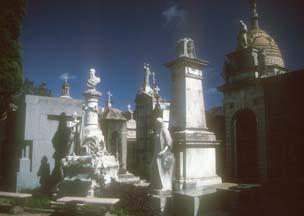 Each plot
had a mausoleum. Each mausoleum had its own distinct style. Some
were made of marble, others of polished dark igneous stone. Some
were sculpted out of concrete. There were many statues of the
departed. Grated doorways and windows allowed a view into the
anterooms. In each anteroom a stairway led down to an underground
crypt.
Each plot
had a mausoleum. Each mausoleum had its own distinct style. Some
were made of marble, others of polished dark igneous stone. Some
were sculpted out of concrete. There were many statues of the
departed. Grated doorways and windows allowed a view into the
anterooms. In each anteroom a stairway led down to an underground
crypt.
We were led through the narrow alleyways between the edifices to the tomb of Eva Peron. One of my favorite monuments was constructed of rough stones that had large ferns growing out of the top and hanging down over the entrance.
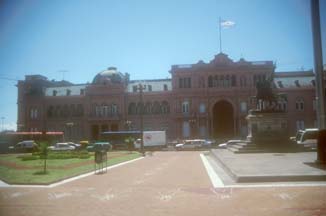 We were taken to the city square
adjacent to the presidential offices, which are housed in the
"Pink House". A tall monument that is emblazoned with
the date of the Creole Revolution of 1810 occupies the center of
the square.
We were taken to the city square
adjacent to the presidential offices, which are housed in the
"Pink House". A tall monument that is emblazoned with
the date of the Creole Revolution of 1810 occupies the center of
the square.
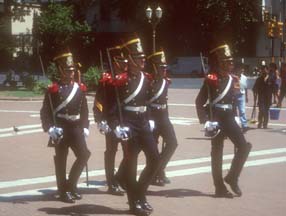 A troop of soldiers in parade dress
marched through the square in slow motion.
A troop of soldiers in parade dress
marched through the square in slow motion.
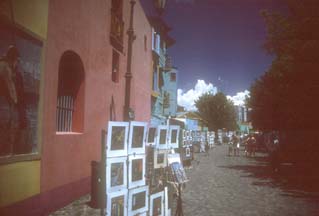 We toured the Boca District. It is
a sort of French Quarter next to the harbor where artists ply
their wares along a cobblestone pedestrian walkway. The houses in
the district are garishly painted with bright colors and complete
disregard for compatibility with the colors on adjacent
structures.
We toured the Boca District. It is
a sort of French Quarter next to the harbor where artists ply
their wares along a cobblestone pedestrian walkway. The houses in
the district are garishly painted with bright colors and complete
disregard for compatibility with the colors on adjacent
structures.
The air temperature and percent humidity were both in the eighties. After a few moments of videotaping, an unfamiliar drop-shaped symbol appeared in the camcorder viewfinder, and it spit out the videotape. It refused to close again. Condensation inside the camcorder had triggered the humidity warning. I had to wait until later in the afternoon for the unit to dry out and begin working again.
I found a shop selling rhodochrosite jewelry and stones inside a mercado. Rhodochrosite is manganese carbonate and looks like pink travertine. The lady behind the counter directed my attention to small, clear, gem-quality pieces mounted in rings and necklaces. I was more interested in a couple of baskets loaded with rhodochrosite spheres. They aren't considered gem-quality, but they have a pretty, lacy, translucent appearance. I bought a couple of the spheres for a fraction of what they cost at the Nature's Own store in Santa Barbara.
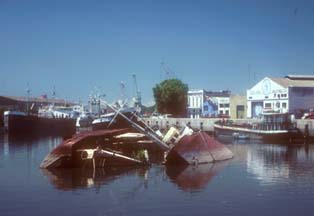 The harbor was just around the corner. There
were several sunken ships lying partially submerged in the slick
brown water.
The harbor was just around the corner. There
were several sunken ships lying partially submerged in the slick
brown water.
Debbie and I had enjoyed our dinner at el Mirasol so much that we took Dad and Elaine there for lunch after the tour. Once again we over-ordered. I had a big order of chicken milanesa with cheese and tomato sauce. Dad and Elaine each ordered a salad. Each salad was big enough to serve the whole table.
The end of the day was occupied with a trip to a local Tango club. The room was filled well beyond a capacity that would be allowed by any U. S. fire department. For some reason, nine people had been assigned to the eight seats of our table. Dad and Elaine were the last to arrive at the table and had to query the head waiter about the seating arrangements. There were several people in the same situation. Dad had been assigned seats at two different tables. He and Elaine went to the other table where Dad found three other members of the Caltech class of 1944, which had been his class.
The steak I was served was overdone and nothing like the wonderful filet that I had gotten the night before at el Mirasol. I chatted with a woman and her daughter from Colorado who were formerly from Brazil. Debbie found herself talking with an older man and his young male companion. Somehow the discussion turned to the issue of gays in the military and the younger man pointed out that he was a reservist himself. The discussion apparently had some direct application to his own situation. The younger man had a tendency to guffaw at his own jokes in a way that quickly wore on Debbie's patience.
After dinner we were treated to a lengthy display of the evolution of the Tango. It began with a moody explanatory performance, all in Spanish, by Aldo. Aldo was the epitome of macho. He had a perfect face to play a mafioso in a Godfather movie. Aldo's monologue was followed by a slow motion, knife fight with another extremely macho character over who got to dance with the pretty tango ladies.
The tango dancers came out dressed at first in costumes appropriate to the late 1800s. The show featured numerous costume changes, reflecting the evolution of style through the last century. The ladies' costumes became scantier with each change.
After our return to the Caesar Park Hotel, I played the Spam episode of Monty Python's Flying Circus. Our flight was scheduled to depart at 5:30 the next morning. We packed our bags and placed them outside the room to be collected for the next leg of the journey.
 Table of Contents
Table of Contents Send a message to Brian.